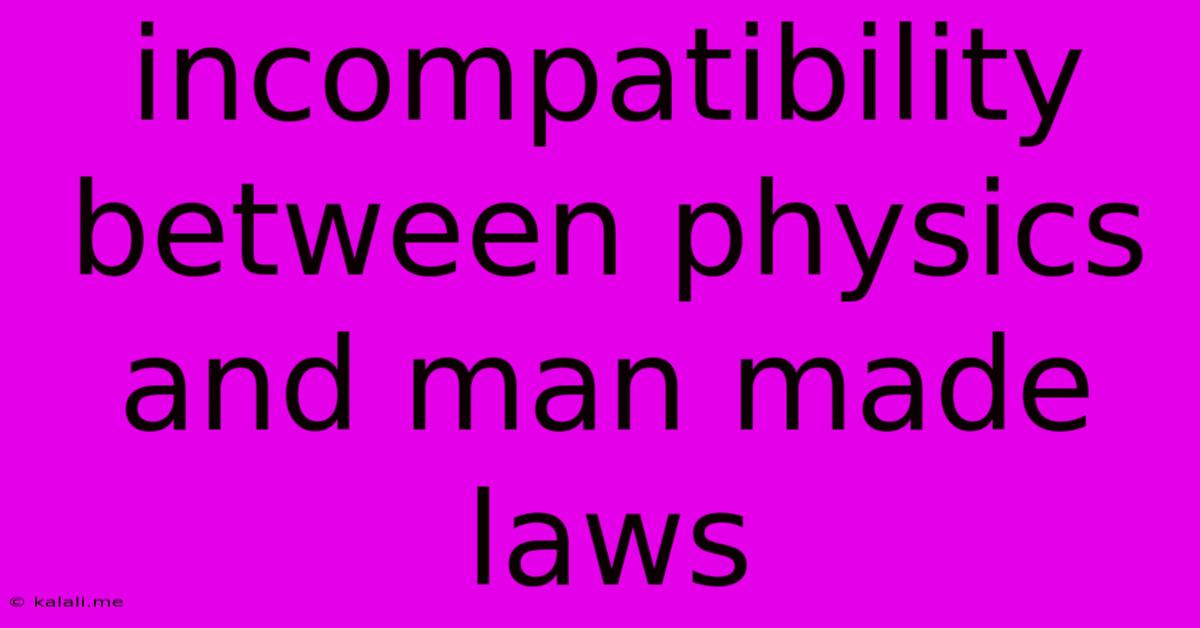Incompatibility Between Physics And Man Made Laws
Kalali
Jun 08, 2025 · 3 min read

Table of Contents
The Incompatibility Between Physics and Man-Made Laws: A Clash of Universal Principles and Human Constructs
Meta Description: Explore the fascinating tension between the immutable laws of physics and the ever-evolving, often arbitrary, rules created by human societies. This article delves into examples where the two clash, highlighting the inherent limitations of human law in the face of universal principles.
The universe operates according to fundamental laws of physics – gravity, thermodynamics, quantum mechanics – forces that govern everything from the smallest subatomic particles to the largest galaxies. These laws are immutable, consistent, and independent of human belief or desire. In contrast, man-made laws are human constructs, designed to govern social interactions, protect rights, and maintain order within a specific society. While both aim to establish order, a fundamental incompatibility often arises between these two systems. This article explores several key areas where this conflict manifests.
The Limits of Human Control Over Natural Phenomena
One primary source of conflict lies in our attempts to regulate natural phenomena through legislation. For example, laws against pollution aim to limit the release of harmful substances into the environment. However, the very processes of pollution – such as the emission of greenhouse gases – are governed by physical laws of chemistry and thermodynamics. While we can create laws to reduce pollution, we can't fundamentally alter the physical processes that cause it. The challenge lies in finding a balance between human regulations and the inherent limitations imposed by natural laws. We might legislate against exceeding certain emissions limits, but the underlying physical processes of combustion and atmospheric dispersion still govern the ultimate environmental impact.
Similarly, laws relating to natural disasters, such as building codes in earthquake-prone regions, strive to mitigate the impact of natural events. Yet, these laws are constantly tested by the overwhelming power of nature, highlighting the inherent limitations of human-made regulations in the face of powerful physical forces. While we can improve building design and land-use planning, we can't entirely prevent the devastation caused by events like earthquakes or hurricanes. The laws of physics governing plate tectonics or atmospheric dynamics will always prevail.
The Challenge of Defining and Measuring Physical Quantities in Legal Contexts
Another area of incompatibility arises from the difficulty of defining and measuring physical quantities within the context of human law. Legal systems often rely on precise measurements and definitions, but the uncertainty inherent in many physical measurements presents a challenge. For instance, determining the exact amount of pollution released by a factory requires complex scientific analysis that might contain inherent uncertainties. These uncertainties can lead to disputes and ambiguity when it comes to enforcing environmental regulations, demonstrating the inherent limitations of applying precise legal definitions to imprecise physical measurements.
Ethical Considerations and the Physical World
Beyond the purely practical challenges, the incompatibility between physics and man-made laws raises important ethical considerations. Advances in physics, such as genetic engineering and artificial intelligence, bring immense potential benefits but also significant ethical dilemmas. While laws attempt to regulate these technologies, the fundamental physical principles underlying them often outpace our ability to create appropriate ethical and legal frameworks. We struggle to create laws that anticipate and effectively regulate the unforeseen consequences of powerful technologies rooted in the complexities of the physical world. For instance, the long-term ecological effects of genetic modification are hard to predict fully, challenging any attempt to legislate against potentially harmful outcomes.
Navigating the Future: Finding a Balance
The inherent incompatibility between physics and man-made laws is a fundamental reality. However, this doesn't mean that human law is irrelevant. Instead, it calls for a more nuanced approach, recognizing the limitations of our ability to control the physical world. Effective law-making requires an understanding of both the social and physical realities, striving for regulations that are both practical and ethically sound, while acknowledging the limits of human control over the fundamental laws of nature. This involves incorporating scientific knowledge into legal frameworks and adapting legislation as our understanding of the physical world advances. The key lies in finding a balance between human aspirations and the unwavering principles governing the universe.
Latest Posts
Latest Posts
-
How To Get Rid Of Gophers Or Moles
Jun 09, 2025
-
One Punch Man Manga Read Online Free
Jun 09, 2025
-
Does Food Regen Health In Beta 1 7 3
Jun 09, 2025
-
Positive And Negative Color Of Wire
Jun 09, 2025
-
Epoxy On A Cracked Copper Pipe
Jun 09, 2025
Related Post
Thank you for visiting our website which covers about Incompatibility Between Physics And Man Made Laws . We hope the information provided has been useful to you. Feel free to contact us if you have any questions or need further assistance. See you next time and don't miss to bookmark.